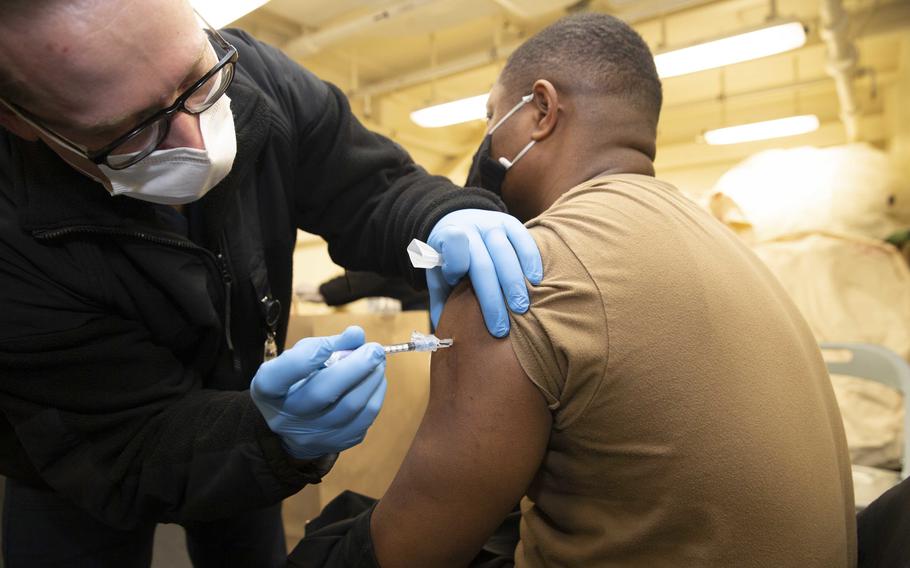
Hospital Corpsman 2nd Class Blaine Grandfield, from Merit, Texas, assigned to USS Gerald R. Ford’s (CVN 78) medical department, administers a COVID-19 booster shot to Air Traffic Controller 1st Class Owusu Poku, from Kunasi, Ghana, assigned to Ford’s operations department, during a COVID-19 booster shot exercise, Jan. 19, 2022. Ford is in port at Newport News Shipyard executing her Planned Incremental Availability (PIA), a six-month period of modernization, maintenance and repairs. (Zack Guth/Navy)
If officials at the Centers for Disease Control and Prevention were hoping that tying an annual COVID booster to the fall flu shot would increase uptake, it isn’t working. Less than 3% of eligible Americans have gotten the new booster this fall. That’s down from last year’s abysmal 17%. And vaccination rates aren’t as high they should be among the most vulnerable — nursing home staff and residents.
Part of this slow start could be due to the delays in getting doses to providers. But some of problems with the rollout were to be expected. Barring the arrival of some virulent new variant, wouldn’t we have done better to focus our limited resources on the oldest and most at-risk?
That’s the logic most other countries have adopted, following the recommendations of the World Health Organization: offering boosters to those at risk of severe disease, but being prepared to re-vaccinate the broader population if a much more dangerous variant emerges.
“For healthy individuals, annual boosters may not be needed, and boosting only when a more virulent variant emerges may be more suitable,” wrote immunologists Ali Ellebedy and Florian Krammer in a commentary published last week in Science.
In such a worst-case scenario, a quickly deployed variant-specific booster campaign would save more lives than an annual fall shot. “If [a variant] … has higher virulence or has mutated in a way that completely circumvents our immune responses, you want to have a system ready where you can respond right away,” Krammer told me. “In that case, you don’t want to wait for the next annual update.”
Technologically, he said, it’s possible to create a new mRNA vaccine in two months. Omicron led to massive waves of illness when it ambushed the world near the end of 2021. “An omicron-specific vaccine in January [2022] would have benefited a lot of people,” he said. Instead, we got a bivalent vaccine in September, aimed at an omicron sub-variant that was by then on the wane.
In the absence of a dangerous new variant, an annual shot for everyone is a bit of a waste. The initial vaccines gave us strong protection against severe disease by inducing the production of immune cells stored in bone marrow. These could last for years. There’s good evidence the first booster improved this long-term immunity, and Krammer said that shot might be better thought of as a part of the primary vaccination series than as a booster.
But additional doses don’t further improve that long-term immunity. Any protection they offer against the current variants comes from circulating antibodies, which start to fade within about three months and have fallen off sharply by about nine months.
It’s possible scientists could create a more powerful vaccine designed to protect against potential new variants and protect against even mild infection. The problem is that researchers no longer have the kind of money that was available during Operation Warp Speed. Now it’s likely to take years between promising animal trials and a working vaccine, Krammer said. “It hurts more because now I’ve seen how quickly we can do things if we want to.”
The pharmaceutical industry’s investment will likely shrink too, due to the decline in demand — Pfizer admitted last week that demand for its boosters and its antiviral, Paxlovid, were both far below what it had predicted.
Monica Gandhi, an infectious disease doctor at the University of California San Francisco, said Krammer’s paper makes important points about future risks. The virus is moving fast. The target of the latest, XBB1.5, accounts for less than 5% of circulating variants today. “It’s a fool’s errand to keep updating for circulating variants.”
It would make more sense to follow the WHO’s guidance: Booster doses should be focused on the most vulnerable to severe illness — because their main purpose is to protect against serious disease. Any new mass vaccination campaigns should be reserved for the possibility of a more dangerous variant.
That would be a better approach than the CDC’s policy, which runs the risk of squandering money and public trust on a broad vaccination campaign that isn’t really necessary. That approach will put the U.S. on the back foot if a more virulent form of the virus does evolve.
F.D. Flam is a Bloomberg Opinion columnist covering science. She is host of the “Follow the Science” podcast. This column does not necessarily reflect the opinion of the editorial board or Bloomberg LP and its owners.